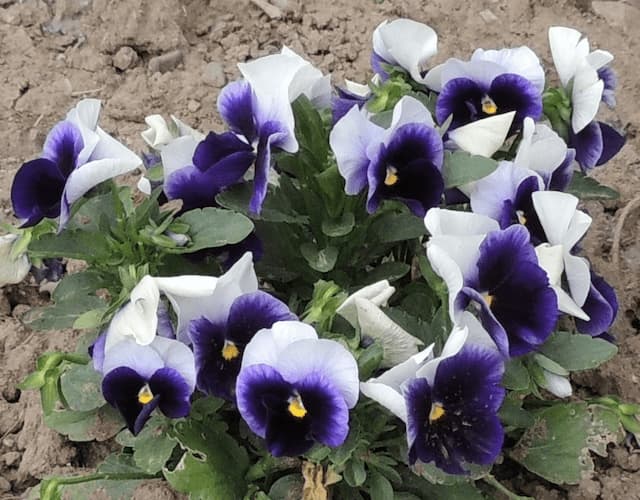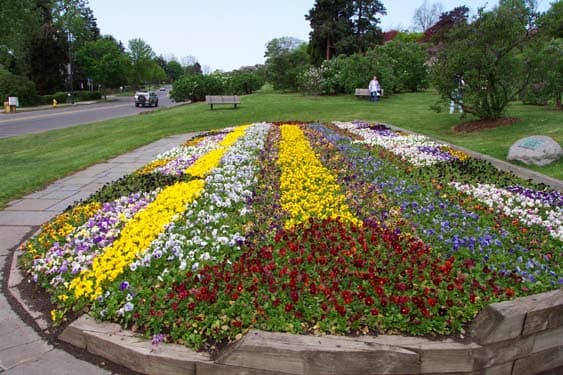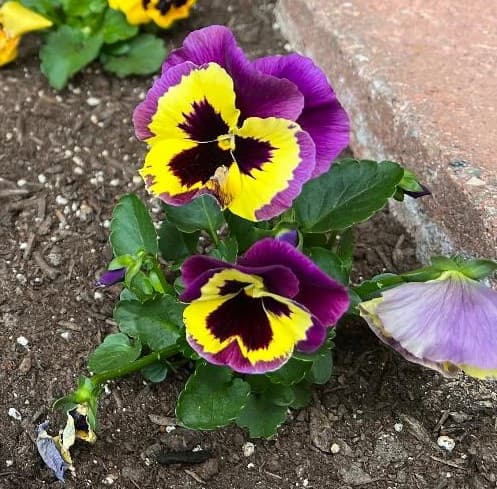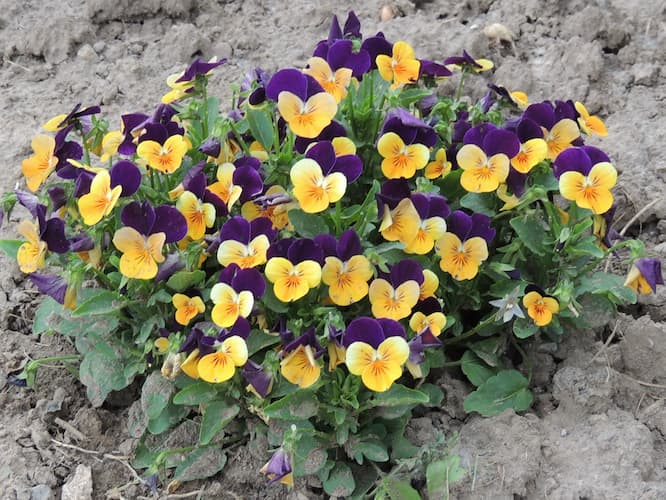How to Grow Pansy Flowers

About Growing Pansies in Your Home Flower Garden
Annual Pansies are one of the earliest flowering plants, blooming right alongside your spring bulbs. These cool-weather members of the violet family herald in the new garden season, with a wide variety of bright, brilliant colors. Vibrant Pansy flowers include almost all colors of the rainbow including black. And, there are many bi-colors, too. There are so many combinations of these profuse bloomers that we don’t think any two are alike! Are you growing pansies in your flowerbed this year? Most gardeners, can’t resist these colorful early bloomers.
Pansies are popular, easy, and fun to grow. Fill an area or entire bed with Pansies for a striking spring effect! They look their best when grown in masses or clumps. Many growers plant pansy beds in a design. The plants readily tolerate a little crowding. Also, they look spectacular growing in windowsills and containers.
Pansies plants are not deer and rabbit resistant. Foraging animals snack on the plants.
Pansy Flower Plant Specifications
Flower colors: Just about every color imaginable. Bright, vibrant flowers bloom in a wide variety of colors and bicolors.
Flower Blooms: Spring, Summer, and Fall, depending upon varieties
Plant Height: Four to nine inches, depending upon variety.
Ideal Soil pH: 5.5 – 7.0.
Light Requirement: Full sunlight to partial sun.
Hardiness Zones: 4 – 11, depending upon variety.
Are Plants Toxic? No.
Deer Resistant? No. Deer and rabbits enjoy snacking on these beautiful flowers.
Native To: Europe and Western Asia.
Plant Type: Annuals, perennials, and biennials.
Botanical Name: Viola x wittrockiana
Other Names: Jump Up and Kiss Me, Love in Idleness

Are Pansy Plants Edible?
YES!!
While the plants are edible, they taste rather bland. As a result, you will seldom find them used in many recipes.
Culinary uses for Pansies is generally limited to garnishes for foods and drinks.
Medicinal Uses for Pansy Plants
Pansy plants are used in a wide variety of herbal and home medical applications. Pansies have anti-bacterial, and anti-fungal properties. Here are some of them:
- Lowers blood pressure.
- It is used to treat fever.
- Treats asthma.
- It eases chest congestion and lung inflammation.
- Treats acne, itchy skin, and other skin conditions.
- Treat epilepsy.
- Eases diarrhea.
- Helps to prevent colds.
- Eases urinary tract infections.
- Use it as a mild sedative.
- It is used in a treatment for varicose veins.
- Use it to treat jaundice and gout.
Light Requirements
Pansies grow best in full sunlight to partial shade. In warmer regions, grow them in partial shade. The flowers last longer in cooler weather and with partial shade.
Pansy Plant Propagation
Annual pansies are grown from seeds. The plants like full to partial sun. Pansies can be directly seeded into your flower garden or seeded indoors for transplanting later. For spring blooms, you need to start your plants indoors six to eight weeks before the last frost.
Sow Pansy seeds early in the season and cover lightly with 1/8″ soil. Water thoroughly once. They germinate slowly.
Note: We highly recommend a heated germination mat, to increase the speed of germination, and for a higher germination rate.
Transplant young Pansy plants into your garden after the last frost date for your area. Space them 6 to 10 inches apart. They will tolerate a little crowding. If you are creating a pansy bed, you may want to create a pattern or color scheme before planting. Or, use mixed varieties.
Final Plant Spacing: Thin seedling or space transplants 6 to 10 inches apart.
Days to Germination: 14 – 21
How to Grow Pansy Flower Plants

Pansies prefer cool to warm climates. They wilt a bit in mid-summer heat. In warmer areas, we recommend growing them in partial shade.
The plants tolerate a variety of soils. Add a general-purpose fertilizer when planting them, then once a month after that.
Soil should be moist, but not wet. Water them during dry periods, once or twice per week.
Keep the plants well-weeded. Apply a layer of much, to help keep the weeds down, and for an attractive appearance.
Once your Pansy plants are established, they should grow well, even if left unattended.
Remove spent blooms, to promote additional blooms, and extend the blooming period. This will also keep the appearance neat and attractive. Also, see deadheading blooms
The plants are hardy annuals. They will often survive the first frost if it is light. They will not survive a hard frost or freeze.

How to Grow Pansy Flowers in Containers and Flowerpots
Pansies are ideal candidates to grow in containers, flowerpots, and windowsill planters. Their cheery blooms will brighten up any area where you grow them. Choose your favorite colors. Or, look for colors that match the setting where they will grow.
In addition to the normal steps for growing them, here’s how to care for them in a flowerpot or container:
- It is important to have a drain hole to allow excess water to drain from the pot.
- Keep an eye on the moisture level. Check the plants every day or two, especially in extended periods of hot, dry weather.
- Keep the soil moist, but not wet. It is okay to let the top of the soil begin to dry between watering.
- When watering the plants, thoroughly wet the soil. Excess water will drain through the hole in the bottom of the flowerpot.
- Nutrients in a flowerpot are limited. So, use fertilizer spikes to feed the plants. Or, apply a light solution of liquid fertilizer once a month.
- Select a sunny to partly sunny location on your deck.
How to Prune Pansy Plants
For biennial and perennial pansy plants, in the spring, remove any dead growth that occurred over the winter. You can also trim it into a more shapely plant.
For all varieties, remove the occasional dead or damaged leaves during the season. Also, branches may become long and lanky. Trim them back to retain the shape of the plant.
Deadheading spent blooms will help to retain the plant’s appearance and encourage more flower buds to form.
Insects and Plant Disease
Annual pansies seldom have problems with insects and disease. If insect or disease problems occur, treat early with organic or chemical insect repellents and fungicide.
Also see: Plant Problems – Identify the causes and find the cures.
Related Articles
Also, people who read this article will like:
See our Pansy Flower Picture Gallery
How to Grow Pansies Plants – by Garden Hobbies
Please support our site. Shop for:
- rmmatthews100@hotmail.com
- 585-721-6528
- Rochester, NY
©1999-2024 GardenersNet.Com, All Rights Reserved

